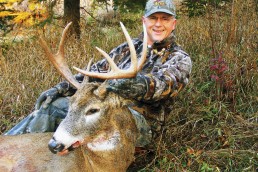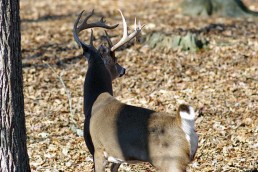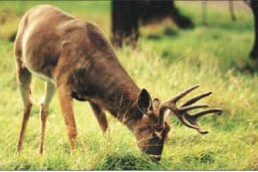Scouting and the High-low Rule
SHARE THIS POST
My experiences suggest that scouting is the key to long-term success with trophy-class bucks. The more you know about your target hunting spot and how the deer travel throughout their territory from season to season, the easier it becomes to plan a hunt that intercepts a buck traveling along one of his many trails.
Each territory has its own idiosyncrasies, and every buck has his own personality. Weather, food sources and cover are just a few factors that can alter and influence buck movement from one year to the next.
Of course, the first thing you need to do is nail down a specific area to hunt. Don’t even begin your search until you are sure a fair number of deer exist in that location, including a few nice bucks. With any public hunting ground, this is most often accomplished by visual roadside sightings of deer. After that, get a topo map and an aerial photograph of that section of land so you can get a better idea of the surrounding territory, as well as the kind of terrain you are dealing with.
Once you have this initial info, further investigate your target area by actually walking the land, utilizing maps and a compass. A portable handheld GPS is also an excellent tool for scouting. Make lots of notes on your map as well as your GPS on what you discover. Continually add to these maps any scouting forays as well as any particular time you hunt a given spot.
Among the things to look for are rub marks on trees made by various resident bucks with their antlers and any ground scrapes. The latter are small areas of pawed-out earth that bucks create throughout the fall in order to mark territory and advertise their presence to all of the deer community. Underestimated sign to look for are simple deer tracks and droppings. The more tracks and droppings, the more likely that a number of deer exist and that they are spending a great deal of time that specific area.
Any time a series of rubs on trees are located, or what is commonly referred to as a “rub line,” slow down and scour the area. Try to locate an actual line of rubs connecting feeding areas to bedding areas. Hopefully, a few ground scrapes will appear along these active rub lines. While scouting this route, keep a watchful eye for anything else in the terrain that might enable you to take advantage of deer travel in a hunting situation. Mostly, this means locating some kind of unique land feature or terrain contour that funnels deer toward a specific spot. This is where you want to set up to hunt.
It’s also important to be a bit discrete in your scouting attempts during the season. Only “walk-scout” a sensitive area during the midday, and only when it’s windy and raining. In fact, it’s never a good idea to go barging through potential hunting spots during key times of deer movement, right after first light and right before dark. You’ll run the risk of ruining your chances before they actually start if you go through sensitive deer-inhabited areas early. Make use of midday wind to disguise your movement or rain to wash away your scent. The elements are your biggest allies for in-season scouting. In a nutshell, take some time to scout and learn your hunting spots intimately, and in the long run you’ll reap the rewards.
The high-low rule: understanding thermals
Hunting from elevated treestands is certainly the deadliest way to hunt for whitetails. Deer concentrate the majority of their efforts on trying to locate danger and predation from ground level; they don’t expect it to come from above. Hunting from a treestand enables the bowhunter to get closer to deer undetected.
An elevated position has additional benefits: For one, it enables one to see more of the surrounding terrain. Getting your overall line of sight above all the thick ground cover can really make a difference. Also, it provides a clearer shot path for arrow placement throughout otherwise thick, low-growing brush. It’s amazing how much more one can see and how much clearer your shot lanes are from just 10 feet of elevation. And getting up over 15 feet really seems to open things up.
Are you enjoying this post?
You can be among the first to get the latest info on where to go, what to use and how to use it!
Most of my stands are set at least 16 feet high, but a few are anchored at heights from 24 to 28 feet. These extra-high, “nosebleed” stands can be set along very steep terrains in the bluff country of western Wisconsin. The additional height is needed to stay above a deer’s line of sight. However, extra-high treestand setups have their drawbacks—the biggest being exaggerated shot angles and smaller vital kill zones. Whenever possible, set your stands lower in order to maximize the best bow shot angles and increased kill zones.
Another great benefit of hunting from a treestand positioned far above ground level is how it affects your own scent stream downwind of your position and across trails deer likely go down. From the ground, you’re sure to get nailed by any whitetail traveling downwind of your position. As soon as you elevate your position, however, your scent is likely to waft undetected overtop a scent-sensitive whitetail. But the actual time of day you hunt and the terrain you’re on can have a huge bearing on how your scent travels no matter how high you are off the ground.
Without getting too technical, remember that human scent is more likely to carry upward for a greater distance in the morning as the sun heats up the ground, creating a rising “thermal” condition. Conversely, your scent is much more likely to drop like a bomb right into the deer’s path after sunset on a cold, clear evening as the thermal reverses itself, cooling the high spots and plunging more dense, cooling air downward.
A warm, strong, southerly wind early in the evening might blow your scent harmlessly away from all deer that are downwind, until sunset. Then, if the wind suddenly dies down after sunset and skies remain clear, any ground heat quickly escapes and is replaced by a massive cool-down that plummets the air downward. In many cases, it even reverses its direction after sunset, pushing your scent right at every deer below you. This is called a “thermal reversal.” Whenever you get “winded” by a deer, but were certain you were in a wind-friendly spot, this is exactly what has happened—you experienced the phenomenon, thermal reversal.
By the way, this thermal reversal is less likely to occur on overcast evenings since cloud cover retains heat better. So, if you’re planning on hunting up high on a ridge top in the evening, make sure the skies are overcast during and beforehand. Very little if any wind direction change takes place on an overcast evening, and air temperatures drop less in these conditions than on a clear evening.
Collectively, every hunter needs to thoroughly scout the entire area. Most of this scouting should be done well before the season, but again, in-season scouting can be done during windy or rainy weather. The more one knows about the area and how the deer travel throughout their home range, the better the chances are that a good-sized deer or two will pass within bow-range. After hunting one specific area for years, definitive patterns are sure to emerge concerning deer travel and rutting patterns.
Whenever on hilly terrain with exaggerated elevations, again, one must always be aware of thermal effects on both deer travel and scent dispersal. Just remember that scent, as well as air currents, rise after sunrise in the morning, but plummet after sunset. Expect a thermal reversal if the wind calms down on a clear, calm evening.
Finally, don’t forget the high-low rule. Hunt high on the ridge tops in the morning, but low along its edges on your late afternoon or evening hunts. Stick by this plan, and you should be on top of undisturbed whitetails on the majority of your hunts this fall.
MWO
SHARE THIS POST
Did you enjoy this post?
You can be among the first to get the latest info on where to go, what to use and how to use it!



